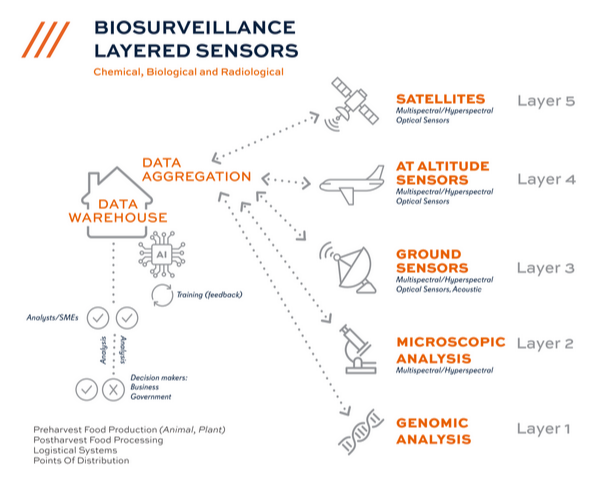Bringing New Technologies to Bear for Biosurveillance

Image credit: CagdasAygun/E+ via Getty Images
Public health, agriculture, the environment, and the food supply could be severely affected by the presence of infectious agents that occur naturally, are the result of accidents, or are intentionally introduced. Yet today, the capability to detect these biological pathogens effectively and rapidly is lacking. This shortfall continues, despite recent key technological advances that could alter the biosurveillance landscape.
The foundations of biosurveillance lie in the One Health concept, which the World Health Organization defines as "an integrated, unifying approach that aims to sustainably balance and optimize the health of people, animals, and ecosystems."1 This approach acknowledges the direct relationship between the health outcomes of people, animals, and ecosystems. What affects one, affects all.
The recent COVID-19 pandemic and the current outbreak of avian influenza in U.S. dairy herds provide ample evidence of the problems faced in rapidly detecting and responding to these outbreaks. They also indicate the importance of identifying these outbreaks prior to the development of clinical disease, which would allow for proactive early intervention, rather than reactively scrambling to address an outbreak after widespread effects have been seen.
To address the gaps, a Biosurveillance Intelligence, Surveillance, and Reconnaissance (BISR) system should be developed. The BISR would be designed to address two mission-critical requirements for biosurveillance: rapid detection and predictive analysis.
BISR would utilize existing, repurposed, and newly developed systems for remote sensing, including multispectral and hyperspectral sensors. The existing technology for differentiating organisms by genomic analysis is proven technology, and hyperspectral sensors are already being used by food processors in their operations. The sensors could be placed on the ground (e.g., within confinement housing or in food processing plants) or on the surfaces of aquatic systems.
Detecting at altitude utilizing balloons, aircraft, and drones, and in space with constellations of satellites equipped with imagery and hyperspectral systems, have also been demonstrated for concentrations of gases for national security purposes. Proven technology such as CubeSats—a class of nanosatellites—could be particularly well adapted to address BISR requirements because of their relatively low cost, ease of deployment, and low latency times (based on the time it takes to circle the earth). Such sensors could be used to great effect during times of emergency.
What needs to be accomplished now is prioritized research and development to rapidly validate the findings of both the imagery and hyperspectral data for different volatile organic compounds (or volatilome) and associate those changes with specific pathogens. Vetting of the data would be based on the development of standard reference cultures—which, through the combination of genomic analysis and hyperspectral microscopic analysis, would provide a definitive signature, or "fingerprint."
Looking for quick answers on food safety topics?
Try Ask FSM, our new smart AI search tool.
Ask FSM →
The validated culture would, in turn, be used to test sensor detection sensitivity in varying environments, matrices (e.g., freshwater vs. brackish water), and environmental conditions and help optimize sensor placement. In this way, the hyperspectral changes associated with a particular disease could be linked to a validated pathogen type.
Beyond looking for the actual pathogen in a particular matrix, which is possible with hyperspectral microscopy, BISR could also be used to identify larger-scale events, such as the detection of exhaled gases and volatile organic compounds or volatilome2 that occur with metabolic changes as disease states progress. During emergencies such as the recent avian influenza outbreak in livestock,3 BISR would not have been used to detect viral particles, but instead to detect the volatilome associated with the disease.
Using this methodology, it is plausible that diseases could be detected before the development of clinical signs, thereby enabling proactive—rather than just reactive—responses. BISR could also be used to monitor the volatilome of mass gatherings, such as travelers at airports and ports of entry or crowds at stadiums, thereby alerting public health officials about potential outbreaks and pandemics. In this way, BISR would support predictive analysis and anticipatory forecasting.
Many of the anticipated changes both in the pathogen itself, such as genetic drift, and the subtle environmental changes that are associated with the pathogen or the disease it causes are impossible for human analysts to detect without the assistance of sensitive instruments to monitor environments, an understanding of the baseline biome, and machine learning. Ultimately, a properly trained artificial intelligence (AI)-based model will also be required.
The sheer volume of data generated by the BISR system would be massive, overwhelming human capacities, given that every pixel generated would include geospatial coordinates. However, BISR's analytical backbone would include AI systems, as well as subject matter experts working directly with the algorithm developers and AI engineers.
Advances in sensor capabilities, coupled with the use of AI platforms, provide new capabilities that could be applied to the detection of biological events in the early stages of an outbreak. In this way, the BISR concept (Figure 1) would provide new tools for early detection, response, mitigations, and ultimately, recovery from an outbreak.
Figure 1. Biosurveillance Layered Sensors Concept—Chemical, Biological, and Radiological

References
- World Health Organization. "One Health." https://www.who.int/health-topics/one-health#tab=tab_1.
- Berenguer, C.V., F. Pereira, J.A.M. Periera, and J.A. Câmara. "Volatilomics: An Emerging and Promising Avenue for the Detection of Potential Prostate Cancer Biomarkers." Cancers (Basel) 14, no. 16 (August 2022): 3982. https://www.ncbi.nlm.nih.gov/pmc/articles/PMC9406416/.
- U.S. Department of Agriculture Animal and Plant Health Inspection Service. "Highly Pathogenic Avian Influenza (HPAI) Detections in Livestock." Last modified April 18, 2024. https://www.aphis.usda.gov/livestock-poultry-disease/avian/avian-influenza/hpai-detections/livestock.










